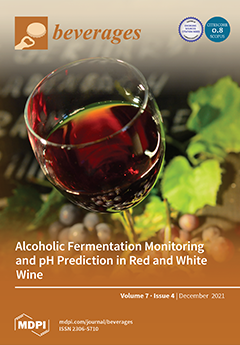The present investigation characterized the diterpene profile of
Coffea canephora coffees, which are natural intervarietal hybrids of Conilon and Robusta. The impact of genetic diversity and environment on these compounds was also evaluated. Five genotypes (clones 03, 05, 08, 25, and 66) from
[...] Read more.
The present investigation characterized the diterpene profile of
Coffea canephora coffees, which are natural intervarietal hybrids of Conilon and Robusta. The impact of genetic diversity and environment on these compounds was also evaluated. Five genotypes (clones 03, 05, 08, 25, and 66) from six growing sites in the State of Rondônia in the western Amazon (Alto Alegre dos Parecis, São Miguel do Guaporé, Nova Brasilândia do Oeste, Porto Velho, Rolim de Moura, and Alto Paraíso) were analyzed. The contents of kahweol, cafestol, and 16-
O-methylcafestol in light-medium roasted coffees were assessed by UPLC. Data were analyzed by ANOVA and Tukey’s test (
p ≤ 0.05). The contents of cafestol and 16-
O-methylcafestol ranged from 96 to 457 mg 100 g
−1 and 75 to 433 mg 100 g
−1, respectively. As for kahweol, from absence up to contents of 36.9 mg 100 g
−1 was observed. The diterpene profile was dependent on genetics, growing site, and the interaction between these factors. A higher variability was observed for kahweol contents. The natural intervarietal hybrid coffees stood out for their high contents of diterpenes and increased frequency of kahweol presence (77% of the samples).
Full article





